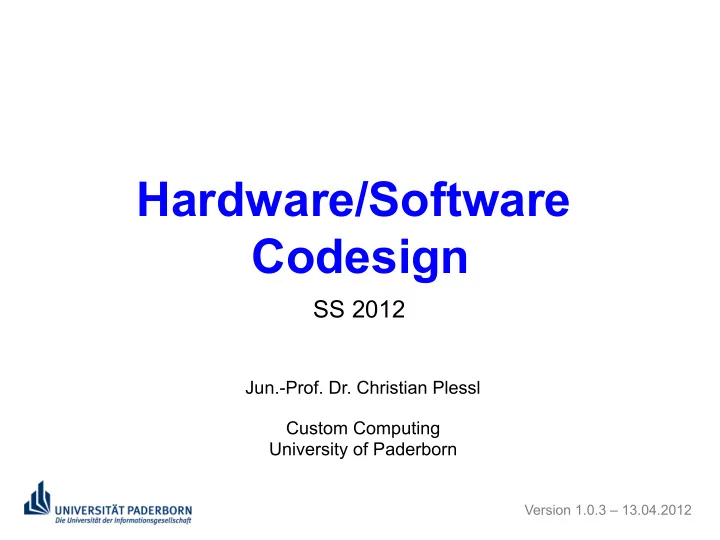

Hardware/Software Codesign SS 2012 Jun.-Prof. Dr. Christian Plessl Custom Computing University of Paderborn Version 1.0.3 – 13.04.2012
Overview • motivation and introduction – goals and main questions in HW/SW codesign • course synopsis • lecture organization 2
HW/SW codesign • what is HW/SW codesign? – integrated design of computer systems that consist of hardware and software components – supported by a systematic computer-aided design process • objectives – handle increasing complexity of computer systems – find better solutions than with a manual process – reduce design time and validation time/cost – explore design trade-offs (performance vs. energy efficiency vs. … ) 3
Performance vs. size trade-offs for cryptography • soft- and hardware implementations of different cryptography algorithms Schaumont 2010 4
Power efficiency of AES encryption • same application / different implementations • vastly different power efficiency depending on specialization/ generality Schaumont 2010 5
General purpose vs. application specific concerns performance energy efficiency extremely high NRE cost ASIC high volume/fixed function only sweet spot high engineering effort FPGA high unit-cost high production cost ASIP competition from off-the-shelf SoC competition from RISC processors DSP operating system support low energy efficiency RISC IP protection effort to change application development effort 6
Mix of technologies in most systems • no “one-size fits all” solution for economical and technological reasons – different requirements – reuse hard- and software implementations – distribute development cost over a variety of products • majority of computer systems use a variety of HW and SW technologies – programmable processing cores (RISC, DSP, uC, … ) – fixed co-processors/accelerators (e.g., cryptography, multimedia, … ) – reconfigurable accelerators (FPGA, coarse-grained arrays) • designing and programming such platforms is challenging – HW/SW codesign addresses this challenge in a systematic way – example: Texas Instruments OMAP processor (system on chip for mobile computing systems) 7
Example: SoC for mobile computer system TI OMAP 4430 system-on-chip Texas Instruments 8
Example: SoC for mobile computer system memory input/output controllers controllers input/output controllers multimedia dual core ARM input/output controllers co-processor embedded RISC GPU DSP security co-processor memory display controllers controllers TI OMAP 4430 system-on-chip Texas Instruments 9
Example: SoC for mobile computer system • HW/SW codesign issues: memory input/output controllers controllers • how to design such a platform? • how to partition the application’s functionality to input/output controllers multimedia dual core ARM input/output controllers components? co-processor embedded RISC GPU DSP • how to determine if a particular mapping is good? • how to generate tools that support such a platform? security co-processor memory display controllers controllers TI OMAP 4430 system-on-chip Texas Instruments 10
HW/SW codesign space Application platform selection application mapping software C C/ASM C/HDL C/HDL HDL platform programming ASIC FPGA ASIP DSP hardware RISC (platform) max flexibility min flexibility min efficiency max efficiency general domain application purpose specific specific Schaumont 2010 (adapted) 11
Driving factors in HW/SW codesign manage design complexity improve performance decrease time-to-market improve energy efficiency reduce design & verification cost reduce power density implement more implement more in software in hardware Schaumont 2010 (adapted) 12
Main questions in HW/SW codesign • hardware/software partitioning – what functionality should be programmable? – what functionality should be implemented in fixed in hardware? – how to create tools (compilers) that can exploit fixed functions? • system partitioning – how to distribute functions to different components? • design space exploration – what system implementation alternatives exist? – what are their characteristics (performance, power, cost) • architecture synthesis – how to translate software to hardware? 13
General approach • abstract and model – treat design of HW/SW system as optimization problem – abstract and formalize problem and design options (e.g., using graph problems, integer linear programing, dynamic programming, … ) • optimize or … – exact or heuristic methods – determine optimal parameter settings and their sensitivity • … explore – explore design space and trade-offs – computer aided design automation guided by human decisions 14
Topics we will look at in this lecture • introduction – target architectures – introduction to compilers • high-level hardware architecture synthesis • partitioning – hardware/software partitioning – system partitioning • design space exploration – estimation of design parameters • instruction set extension 15
Relation to other lectures in CS curriculum • Bachelor level courses – GRA/GTI § fundamentals of digital logic and computer architecture – Embedded processors § architecture of embedded processors, micro controllers and DSPs § compilers for special purpose processors – Embedded Systems § modeling languages, hardware verification • Master level courses – Reconfigurable Computing § FPGA technology (architecture, methods and applications) – Architektur Paralleler Rechnersysteme § parallel programming models and languages, high-performance computing 16
Benefits from attending this course • Learn about – challenges and approaches in modern system design – target architectures – useful optimization methods – a current and active research area 17
Course Organization • Lecture Friday, 11:15-12:45, O1.267 • Exercises Friday , 13:15-14:00, O1.267 – mix of pencil and paper and programming exercises – try to solve the problems yourself – discussion of the problems in the exercises • Contact: Christian Plessl email: christian.plessl@uni-paderborn.de office: O3.110, phone: 60-5399 • Web page http://homepages.uni-paderborn.de/plessl/lectures/2012-Codesign • Course Materials on the web – lecture slides, exercise sheets, selected papers 18
Literature and acknowledgements • this course is based on materials from the following books … – Patrick R. Schaumont, A practical Introduction to Hardware/Software Codesign . Springer 2010. doi:10.1007/978-1-4419-6000-9 (available in full text within UPB network) – Jürgen Teich and Christian Haubelt. Digitale Hardware/Software-Systeme. Synthese und Optimierung . Springer, 2007. doi:10.1007/978-3-540-46824-0 (available in full text within UPB network) – Giovanni De Micheli, Synthesis and Optimization of Digital Circuits. McGraw-Hill, 1994. • … and on lecture materials from the Bachelor-level lecture “HW/ SW Codesign” – taught by Christian Plessl (2009-2010) and previously by Marco Platzner 19
Changes • v1.0.3 (2012-04-14) – corrected minor typos • v1.0.2 (2012-04-10) – updated for SS2012 • v1.0.1 (2011-04-01) – added more slides illustrating the FPGA toolflow 20
Recommend
More recommend